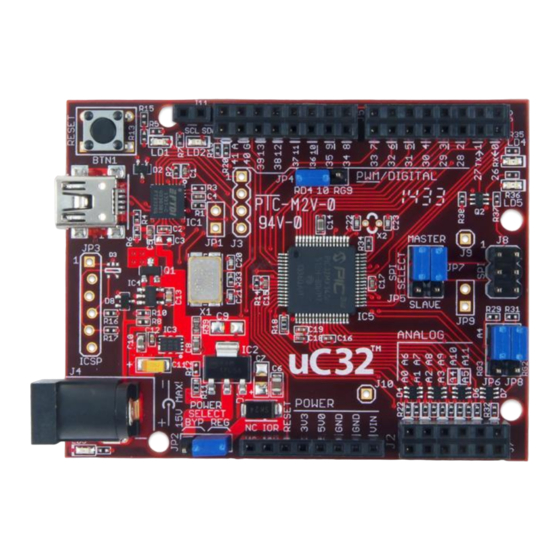Digilent chipKIT uC32 참조 매뉴얼 - 페이지 9
{카테고리_이름} Digilent chipKIT uC32에 대한 참조 매뉴얼을 온라인으로 검색하거나 PDF를 다운로드하세요. Digilent chipKIT uC32 18 페이지.

chipKIT™ uC32™ Board Reference Manual
3.5
Peripheral I/O Functions
The PIC32 microcontroller on the uC32 board provides a number of peripheral functions. The following peripherals
are provided:
UART port 1: Asynchronous serial port. Pin 0 (RX), Pin 1 (TX). These pins are connected to I/O connector J6 and are
also connected to the FT232R USB serial converter. It is possible to use these pins to connect to an external serial
device when not using the USB serial interface. This uses UART1 (U1RX, U1TX) on the PIC32 microcontroller.
UART port 2: Asynchronous serial port. Pin 39 (RX), Pin 40 (TX). This uses UART2 (U2RX, U2TX) on the PIC32
microcontroller.
SPI: Synchronous serial port. Pin 10 (SS), Pin 11 (MOSI), Pin 12 (MISO), Pin 13 (SCK). This uses SPI2 (SS2, SDI2,
SDO2, SCK2) on the PIC32 microcontroller These signals also appear on connector J8.
Jumpers JP5 and JP7 are used to select whether the uC32 operates as a Master (transmit on MOSI, receive on
MISO) or a Slave (transmit on MISO, receive on MOSI) device. The shorting blocks on JP5 and JP7 are normally
placed in the Master position for the uC32 to function as an SPI master.
Jumper JP4 is used to select PWM output or the SPI SS function on Pin 10. The shorting block on JP4 should be in
the RD4 position to select PWM output. It should be in the RG9 position to select the SPI SS function. JP4 will
normally be in the RD4 position. In general, the only time it needs to be in the RG9 position is when the uC32
board is being used as an SPI slave device.
2
2
I
C: Synchronous serial interface. The dedicated I
C signals can be found on J11. In addition, the PIC32
2
microcontroller shares analog pins A4 and A5 with the two I
C signals SDA and SCL. Jumpers JP6 and JP8 are used
2
to select whether the analog pin functions or the I
C pin functions are being used. The shorting blocks are placed in
the A4/A5 position to select the analog input function or general digital I/O. They are placed in the RG3/RG2
2
position to use the pins for I
C operation. This uses I2C1 (SDA1, SCL1) on the PIC32 microcontroller.
2
Note: The I
C bus uses open collector drivers to allow multiple devices to drive the bus signals. This means that
pull-up resistors must be provided to supply the logic high state for the signals. These pull-up resistors are not on
the uC32 board and must be provided externally. The required resistance of the pull-up resistor to use depends on
the total number of devices on the bus, the length of wire, and the clock speed being used. It essentially depends
on distributed capacitance on the bus. The higher the distributed capacitance and the faster the clock speed, the
smaller the resistance should be. Values typically used are in the range of 2K to 10K ohms.
PWM: Pulse width modulated output. Pins 3 (OC1), 5 (OC2), 6 (OC3), 9 (OC4), and 10 (OC5).
External Interrupts: Pin 38 (INT0), Pin 2 (INT1), Pin 7 (INT2), Pin 8 (INT3), Pin 35 (INT4)
User LEDs: Pin 13 (LD4), Pin 43 (LD5). Pin 13 is shared between a connector pin and the LED. Pin 43 only goes to
the LED and not any connector pin. Driving the pin high turns the LED on, driving it low turns it off.
A/D Converter Reference: Labeled A, the left-most outer pin on connector J5. This is used to provide an external
voltage reference to determine the input voltage range of the analog pins. The maximum voltage that can be
applied to this pin is 3.3V. This pin can also be used as digital pin 42.
RTCC: Real Time Clock Calendar. The PIC32 microcontroller contains an RTCC circuit that can be used to maintain
time and date information. The operation of the RTCC requires a 32.768 KHz frequency source. Crystal X2 (not
loaded), just above and to the right of the PIC32 microcontroller IC, is provided for you to solder a 32 KHz watch
crystal. The Citizen CFS206-32.768KDZF-UB crystal can be used in this location.
RESET: The PIC32 microcontroller is reset by bringing its MCLR pin low. The MCLR pin is connected to the P32_RST
net on the circuit board.
Copyright Digilent, Inc. All rights reserved.
Page 9 of 17
Other product and company names mentioned may be trademarks of their respective owners.
